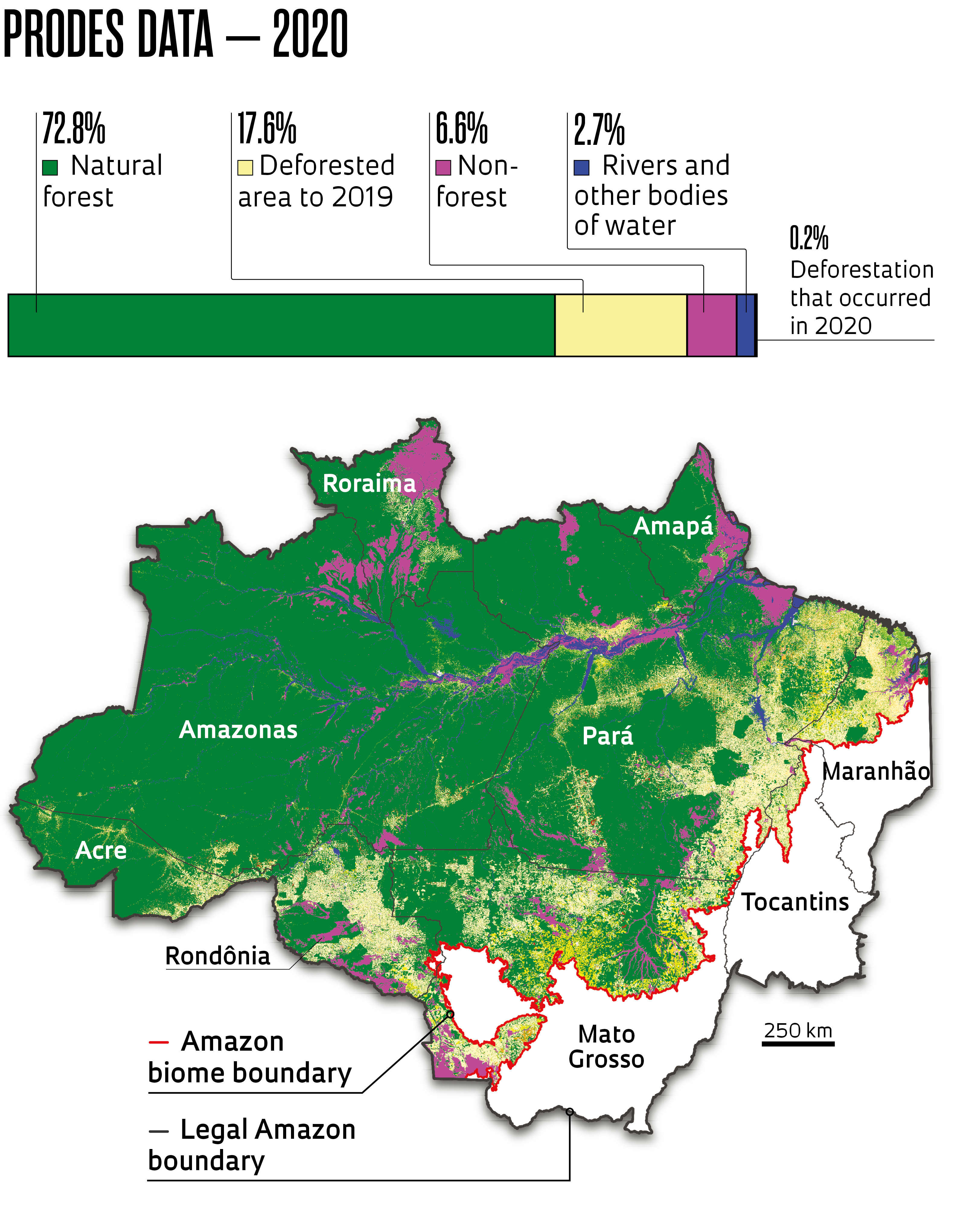EMBRAPA and INPE resume the mapping of land use and cover in the Amazon, 14% of which is occupied by pasture and agriculture
What are the deforested areas in the Legal Amazon used for? In 2008, Brazil’s National Institute for Space Research (INPE) and the Brazilian Agricultural Research Corporation (EMBRAPA) launched the TerraClass project, with the objective of identifying how land (where natural vegetation has been removed) is being used. Based on the location and level of deforestation detected by the PRODES system, teams from both organizations used remote sensing to determine whether the rainforest had been cleared for crops, pastures, or, much more rarely, urban areas and other forms of occupation.
They created overviews of the Legal Amazon for five years: 2004, 2008, 2010, 2012, and 2014. Due to a lack of funding and personnel, TerraClass stopped conducting surveys in recent years. However, now it has returned. This new project, funded by the Ministry of Defense’s Management and Operations Center for the Amazon Protection System (CENSIPAM), recently shared 2020 land use data online. Due to methodological changes, it has not yet been possible to compare the information from 2020 with that from previous years.
In the past, TerraClass processed and analyzed data relating to the Legal Amazon, an area of approximately 5 million square kilometers (km2) encompassing the entire Amazon rainforest and parts of the Cerrado (a wooded savanna biome) and Pantanal. Currently, the project is generating information specifically related to the Amazon biome, which is approximately 800,000 km2 smaller than the Legal Amazon.
One of the reasons for this change was the creation of a Cerrado-specific TerraClass in 2018 — the Cerrado is one of the largest agricultural regions in Brazil. This new approach thus eliminates overlaps and redundancies by using two distinct initiatives to focus on the two largest Brazilian ecosystems, which cover more than 70% of the national territory.
“We are just finishing the process of migrating the old TerraClass to this new format,” said agronomist Júlio César Dalla Mora Esquerdo of EMBRAPA Digital Agriculture in Campinas, one of the project’s coordinators. “We plan to make data for 2022 available soon.” The team also intends to look back into the past and map land use and cover for 2016 and 2018, at which time TerraClass Amazônia was no longer in operation.
The Brazil version of TerraClass was also created with support from the Brazilian Institute of Geography and Statistics (IBGE) to map land use across all biomes in the country. “Knowing our national territorial dynamics will enhance the synergy between economic, social, and environmental development policies,” said Alexandre Coutinho, a researcher at EMBRAPA Digital Agriculture.
According to the 2020 data, 72.8% of the Amazon biome was occupied by native forest, while 3.7% was occupied by secondary forest (abandoned deforested areas in the process of regeneration). The total deforested area accounted for 17.6% of the total area, which was almost entirely used for livestock and agriculture. Pasture and soybean, along with maize and cotton, accounted for 14% of the surface area of the Amazon. Pasture covered almost nine times more land than crops. Areas classified as nonforest areas — comprising mainly nontree vegetation and, to a lesser extent, urbanized areas — represented 6.7% of the total biome. Rivers and other bodies of water covered 2.7% of the Amazon.
TerraClass also revealed that 0.2% of the Amazon, equivalent to approximately 10,000 km2 of rainforest, was removed in 2020. “At the moment deforestation occurs, we do not know what the land will be used for,” noted Esquerdo. “We cannot, therefore, define the immediate use of the land.”
The TerraClass 2020 numbers are similar to those presented by the most recent MapBiomas survey. The initiative is facilitated by the Observatório do Clima, a nongovernmental organization (NGO) that brings together universities, technology companies, and Brazilian civil organizations. According to this NGO, 15.5% of the Amazon biome was occupied by agricultural activities in 2022, equivalent to approximately 650,000 km2. Since 1988, the area occupied by pasture and crops has increased 4.6-fold.
An INPE study published in the journal Acta Amazônica in 2020 compared old maps of land use and cover in the Amazon biome created by TerraClass and MapBiomas. The key conclusion of the paper was that despite the methodological differences, between 87.4% and 92% of the results of the two initiatives were similar.
Amazon+10 Initiative
Land use is one of the key concerns of the Amazon+10 Initiative, alongside issues related to biodiversity, climate change, bioeconomy, biotechnology, and the living conditions of the residents of Amazonia. Launched in July last year, the program is run by Brazil’s National Council of State Research Funding Agencies (CONFAP) and National Council of Science, Technology, and Innovation Departments (CONSECTI). It also has a partnership with the Brazilian National Council for Scientific and Technological Development (CNPq).
At the end of last year, 39 research proposals were accepted from 19 Brazilian states. The Association of State Research Funding Agencies (FAP) allocated R$41.9 million to the projects chosen after the program’s first call. In November of that year, Amazon+10 issued a second call for proposals, with a planned budget of R$59.2 million and a focus on funding scientific expeditions to the region.
Republish
